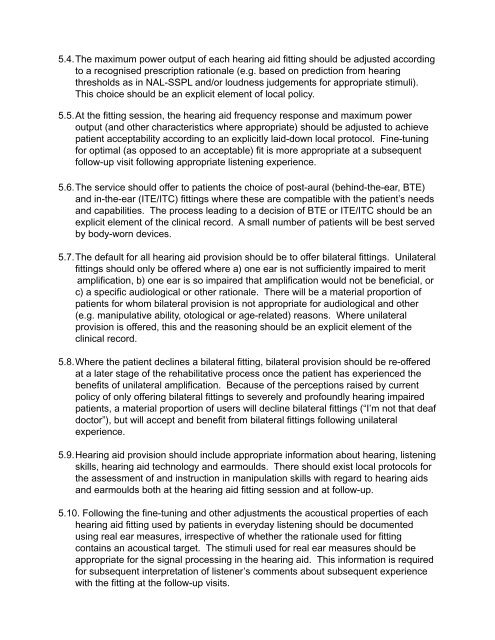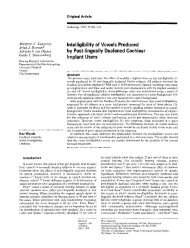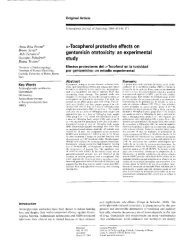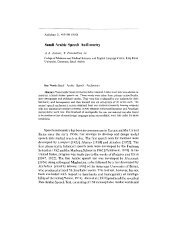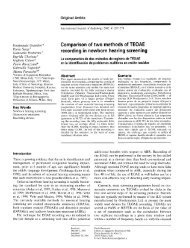Good Practice Guidance for Adult Hearing Aid Fittings and Services ...
Good Practice Guidance for Adult Hearing Aid Fittings and Services ...
Good Practice Guidance for Adult Hearing Aid Fittings and Services ...
You also want an ePaper? Increase the reach of your titles
YUMPU automatically turns print PDFs into web optimized ePapers that Google loves.
5.4.The maximum power output of each hearing aid fitting should be adjusted according<br />
to a recognised prescription rationale (e.g. based on prediction from hearing<br />
thresholds as in NAL-SSPL <strong>and</strong>/or loudness judgements <strong>for</strong> appropriate stimuli).<br />
This choice should be an explicit element of local policy.<br />
5.5.At the fitting session, the hearing aid frequency response <strong>and</strong> maximum power<br />
output (<strong>and</strong> other characteristics where appropriate) should be adjusted to achieve<br />
patient acceptability according to an explicitly laid-down local protocol. Fine-tuning<br />
<strong>for</strong> optimal (as opposed to an acceptable) fit is more appropriate at a subsequent<br />
follow-up visit following appropriate listening experience.<br />
5.6.The service should offer to patients the choice of post-aural (behind-the-ear, BTE)<br />
<strong>and</strong> in-the-ear (ITE/ITC) fittings where these are compatible with the patient’s needs<br />
<strong>and</strong> capabilities. The process leading to a decision of BTE or ITE/ITC should be an<br />
explicit element of the clinical record. A small number of patients will be best served<br />
by body-worn devices.<br />
5.7.The default <strong>for</strong> all hearing aid provision should be to offer bilateral fittings. Unilateral<br />
fittings should only be offered where a) one ear is not sufficiently impaired to merit<br />
amplification, b) one ear is so impaired that amplification would not be beneficial, or<br />
c) a specific audiological or other rationale. There will be a material proportion of<br />
patients <strong>for</strong> whom bilateral provision is not appropriate <strong>for</strong> audiological <strong>and</strong> other<br />
(e.g. manipulative ability, otological or age-related) reasons. Where unilateral<br />
provision is offered, this <strong>and</strong> the reasoning should be an explicit element of the<br />
clinical record.<br />
5.8.Where the patient declines a bilateral fitting, bilateral provision should be re-offered<br />
at a later stage of the rehabilitative process once the patient has experienced the<br />
benefits of unilateral amplification. Because of the perceptions raised by current<br />
policy of only offering bilateral fittings to severely <strong>and</strong> profoundly hearing impaired<br />
patients, a material proportion of users will decline bilateral fittings (“I’m not that deaf<br />
doctor”), but will accept <strong>and</strong> benefit from bilateral fittings following unilateral<br />
experience.<br />
5.9.<strong>Hearing</strong> aid provision should include appropriate in<strong>for</strong>mation about hearing, listening<br />
skills, hearing aid technology <strong>and</strong> earmoulds. There should exist local protocols <strong>for</strong><br />
the assessment of <strong>and</strong> instruction in manipulation skills with regard to hearing aids<br />
<strong>and</strong> earmoulds both at the hearing aid fitting session <strong>and</strong> at follow-up.<br />
5.10. Following the fine-tuning <strong>and</strong> other adjustments the acoustical properties of each<br />
hearing aid fitting used by patients in everyday listening should be documented<br />
using real ear measures, irrespective of whether the rationale used <strong>for</strong> fitting<br />
contains an acoustical target. The stimuli used <strong>for</strong> real ear measures should be<br />
appropriate <strong>for</strong> the signal processing in the hearing aid. This in<strong>for</strong>mation is required<br />
<strong>for</strong> subsequent interpretation of listener’s comments about subsequent experience<br />
with the fitting at the follow-up visits.


